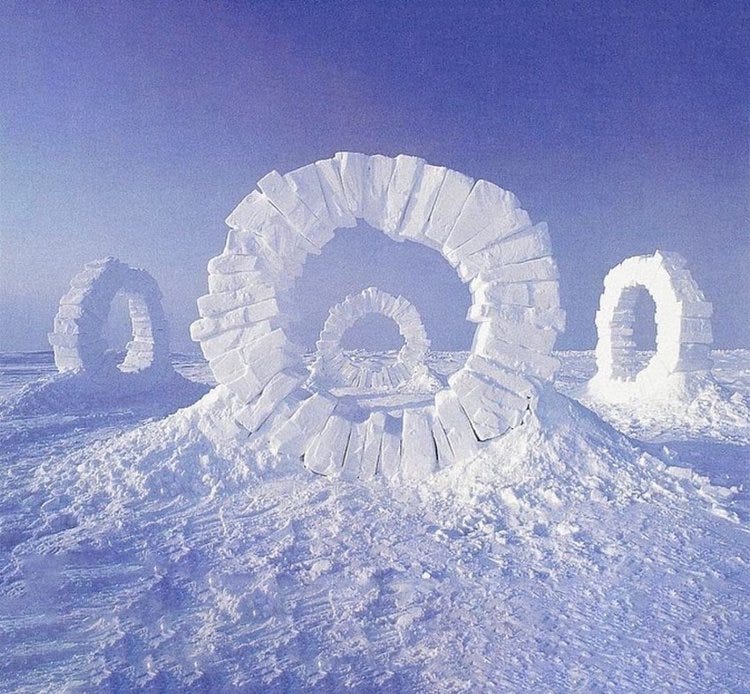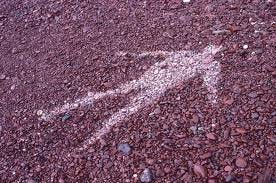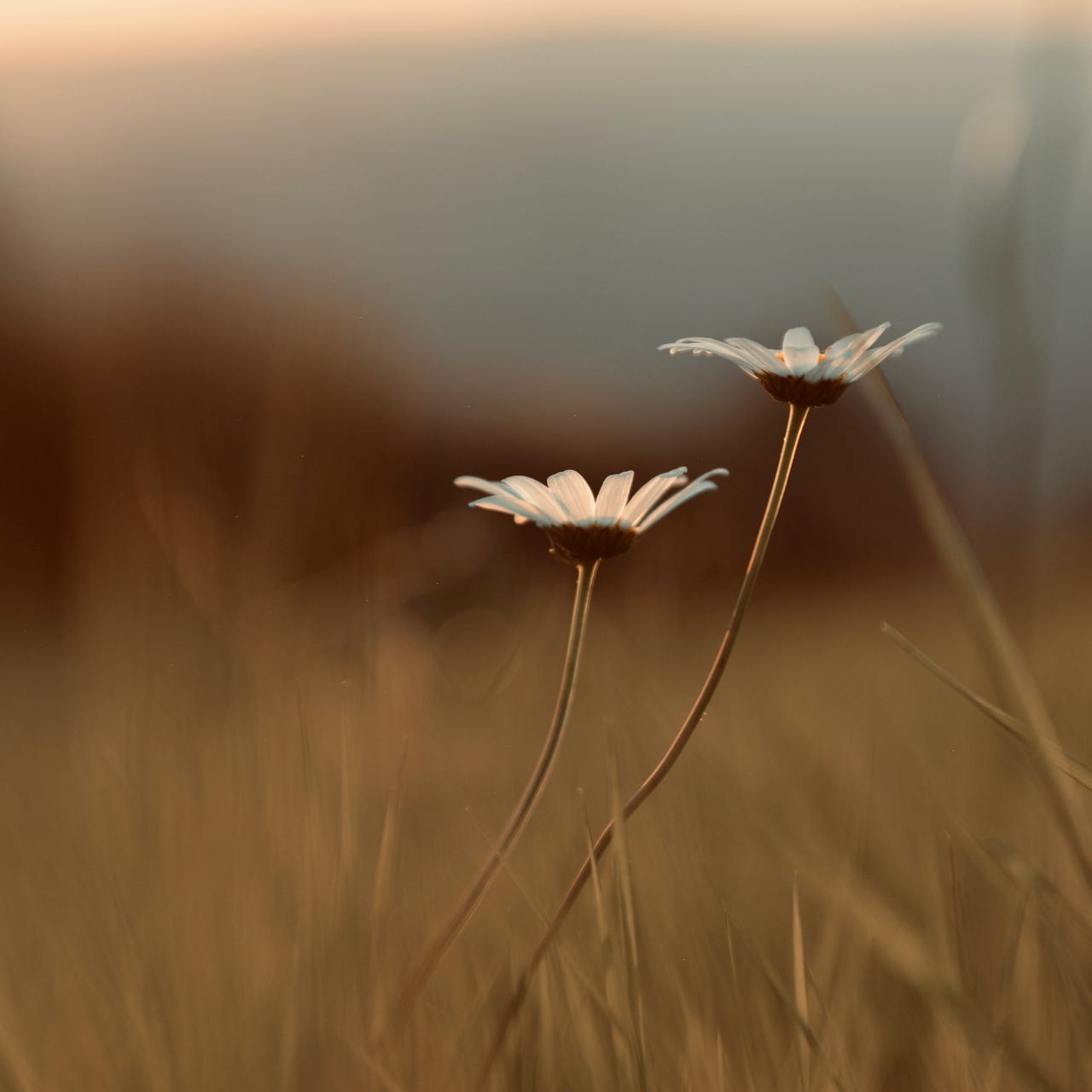How different would the world be if we tread so lightly upon the Earth that our existence evaporates like mist cast asunder by the breeze?
Sculptor, Andrew Goldsworthy (Andy), journeys into the wilderness to quietly create art, and when complete, leaves it for someone to discover. The chances of discovery, however, are slim.
For the above work, Touching North, Andy voyaged to the North Pole, a seasonal changing landscape upon which his creations would be as ephemeral as nature’s own art. He valued the location for it being commons land, a landscape which belongs to no-one, but also for the connection that it offers.
When I work with winter I work with the North. The further North I go the stronger its presence. I want to follow North to its source - to try and come to terms with it - in the same way I work with a leaf under the tree from which it fell.1
Fortunately, Andy found a patron in gallery owner, Fabian Carlsson, who funded the three day trip to meet Inuit artist, Looty Pijamini. Looty taught the small team how to cut ice blocks so Andy could proceed with his work.
He constructed four large upright circles, like windows to the cardinal points of the horizon, yet at the pole, you are always facing south. To walk around the structure is to circumnavigate the pole. The most distinctive feature and point of the piece is that it will return to the place from which it came, as if it had never been.
While he has travelled the world and created sculptures in the most remote of places, he prefers to do most of his work near his home in Dumfriesshire in Scotland. It’s where, he says, he can learn most about nature and his relationship with it. His art is a personal journey, one which like Cut Piece by Yoko Ono, transforms the artist. Andy’s work is a spiritual quest:
I’m a sculptor. I work directly with the land, working with materials I find in the landscape whether it be Japan, the North Pole, but it’s the landscape around my home which is most important to me and it’s that landscape to which I keep returning and is the place that I can learn most about nature and my relationship with it.
His home is where his work is rooted. Even though Touching North was created in as extreme a place as you’ll find, it is connected to small ice sculptures he creates in the shadows of caverns lining the Scaur River in Dumfriesshire. Similarly, the red sandstone which he finds and likes to make use of in his home environment is the same natural red to be found in California, Japan and elsewhere across the globe. He used to refer to it as a vein which runs around the world, making him astutely aware of the connections and flows through the Earth. While in Japan, he noticed a large rock like one back home, a canvas for many of his works. He cloaked the Japanese rock in red maple leaves pairing it with the home stone which he’d covered in the bright yellow of Scotland’s autumnal leaves emphasising their inextricable link.
Even in his local environment, many of Andy’s sculptures are relatively inaccessible and unlikely to be witnessed by anyone. A nearby river, with its cavernous rock walls, is the site for many of his pieces. During a BBC filming he brought the camera team to a remote ridge where he spotted five small pools of water beneath them. On the walk there, he collected hazel leaves, the colour of which turns a vibrant green when wet. He floated the leaves to form a coat over each of the five pools, creating an animated connected effect alongside the river’s flow. The next day, his art is gone.
Andy described the unpredictability of the river as more difficult to work with than the sea. Even during creating his art, the piece may not work depending on how it behaves. It creates a tension, something he embraces and enjoys working with. In contrast to the scientific human endeavour to understand and control nature, he works to understand and respect.
Andrew Goldsworthy is attracted to the banal. In working with common items he gains a new appreciation for how extraordinary they really are. An oak tree, located on the lands of a historic stately home, Capenoch, is like the river rock, a canvas for many of his works of art. Mud is the medium with which he sculpts. In the shade of the tree, cattle often seek respite, making it hard and compacted in dry weather, but muddy when it’s not. It’s raining, and if too wet, the piece will not work.
Due to this time and weather dependency, Andy accepts failure as part of his artistic process. At the Capenoch tree, he’s often had to abandon his work. For one piece he drew with dandelions which required a patient wait for them to open. During the creation he had to contend with the curiosity of cows who decided his art materials were good to eat.
During another project, he uses slate to draw on slate, hoping to create a curved shape to be perceived as floating on top of the stone. It rains. Twenty minutes before it is finished it is washed away. Rather than get frustrated, he instead lies on a heap of slate. When he stands, he has left a ‘rain shadow’.
Much of the information in this post is derived from the BBC’s programme featuring the creation of three pieces of art by Andrew Goldworthy. The first is below and from there you’ll find the second two.
Up Next
While Andy Goldworthy chooses remote, short-lasting creations, other artists prefer larger and more dominant marks upon the landscape. In this post, we’ll explore the less ephemeral world of land art.
Embers
It started when the sun began to shine. I stepped out into the garden and embarked on all those design plans I hold in my head, clear as if I’d committed them to paper. Tentative at first, raking a few sacks of leaves, with which I created weed suppressant for paths between hugel beds. As fitness improved, a mound of building sand which had turned into a weed infested hillock is now the base for a sacred space. Even stronger, I perched at the top of a tall rock face, to do a job I’ve put off for the last couple of years, a balancing act to clear brambles and overgrown vines that would have invaded the roof of the house.
Somewhere during all this, I felt overwhelmed. Not with the tasks ahead of me in the garden, I couldn’t be happier with progress. Working towards a dream that will materialise after I’m a long gone. Nor was it with the rainy day tasks ahead of me of turning grotty corners into a functional aesthetic. The overwhelm had instead to do with Substack.
It was a Note which brought the feeling into focus and clarified a way to move forward so I would not give up on the enterprise altogether:
I’ve been as dullified by the app as I was on other social media platforms. Scrolling but not engaging, never taking anything in. I was increasingly aware of its effects, so sent all subscriptions to email to avoid using the app. This, after two weeks, led to a very full inbox which was even more daunting than ever.
What “feels much more aligned for me and creates a spaciousness …” for enjoying the platform has been to spend time delving deeper into an individual Substack. As I said in my response, the approach helps me get to know the writer (quite often a reader), follow their journey from earlier posts to where they are now, and as I’ve gotten to know them, it’s easier to maintain the connection after. Their posts are more accessible and exciting to read as I now have a wider context for engaging with them.
So for this next week, as a gentle step into finding my way back to Substack outside the bounds of The Fiertzeside, it seems that life on a beautiful hill in France would be a good place to spend some time.
Mayhap you’d also like to spend some time with Susie too?
https://delibere.fr/andy-goldsworthy-touching-north-1989/ translated using Safari’s page translator.








Safar, I relate to the problem of your last part and congratulate you on the solution. I hope the abundance of good reading is so pronounced that none of us are missed when we read a little, disappear a little, read a little, and so on. I imagine something like this must be widespread.
Before I launch into the topic of scrolling blindly in Notes here and any other Social Media site, I just want to apologise for taking so long to get to this post Safar. I only received an email notification this afternoon that you shared my publication or I would have been here much sooner… I’m so behind with reading which is something that overwhelms me even more than a full up inbox anywhere. I try to read and comment and share if necessary those that are kind enough to mention A Hill and I as fast as possible but we don’t seem to get the emails or notifications as the post is published.
So a huge thank you for sharing, reading and commenting on some of my early posts… I feel very warmed and emotional. 🥹
I may have said this before to you; I don’t really know what I expected when I posted my first letter, it was more of a ‘what have I to lose’ feeling than expectation I think. Now, a year on, I’m flabbergasted/overwhelmed/breathless and to coin the French phrase, ‘bouleversé ! Not only by the quality of writing but by the amount. I want to read it all and I can’t, a fact which has started to build tension and frustration. I don’t really know the answer either… other than I don’t think anyone expects us to read, comment or react immediately. There is no algorithm so there should be no feeling of need to be there the instant it’s posted. I’m trying to hold on to that…
Like you I always want to know the full story too, I need insight into who and how and where if possible, yet more reading but worth while. So, slowly I’m reading through all those I subscribe to. This doesn’t help with the gathering of new subscribers but as has been often said here, it’s better to have a handful of loyal followers who genuinely enjoy what we do than 10000 ghosts!
Lastly, and definitely most importantly, I love that you began your letter with this…
« How different would the world be if we tread so lightly upon the Earth that our existence evaporates like mist cast asunder by the breeze? »
and then continued with Andy Goldsworthy and his gentle journeys into wild art.
Your whole letter just made me sigh…. X